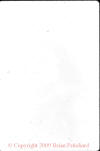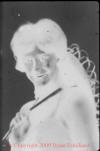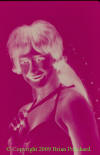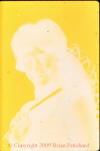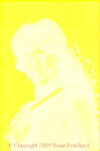The dyes used in colour films have to satisfy two main criteria; they have to be able to be formed in the colour process from a reaction between the silver halides being developed, the couplers in the emulsion and the colour developing agent in the developer and they have to have certain colour photographic qualities. The chemical requirements restrict the number of dyes, so less than perfect dyes have to be used. ‘Technicolor’ films were mechanically printed so the dyes could be chosen purely for their photographic qualities, hence the excellent colour of ‘Technicolor’ and their reduced fading; similarly ‘Kodachrome’ films have the dyes introduced during three colour development stages, so again the dye stability and colour quality are better than negative/positive processes.
A dye used in colour film should ideally be what is described as narrow-cut.
Each of the three dyes used should control only one colour. For example the magenta dye should only control green light and let all of the blue and red light through. When a dye is controlling colours it should not control, it is called unwanted absorption.
The diagrams illustrate the spectrophotometric curves of the dyes in each of the layers. The straight lines show the ideal curve. The magenta curve shows unwanted control in the blue area, and shows that in the red area the dye is quite acceptable. The cyan dye has unwanted absorption in the green part of the curve. The yellow dye is the best of the three showing less unwanted absorptions.
Hansen and Vittum of the Eastman Kodak Company solved this problem, or at least reduced its effect, by introducing coloured couplers. Two of the layers in the film have coloured couplers, the magenta and the cyan layer, yellow dyes are usually sufficiently narrow cut and in addition a suitably magenta coloured coupler is not available. These coloured coupler layers are called masks. The magenta layer transmits some blue light so the coupler is coloured yellow and the cyan layer transmits some green light so is coloured magenta; the combination of magenta and yellow make up the orange colour known as the mask in colour negatives. Different stocks have different dyes and require different colour masks so each stock has a slightly different coloured mask.
Cyan layer with and without Magenta layer with and without
Magenta coloured mask yellow coloured mask
Because the coupler is used to form the dye, the amount of mask will be inversely proportional to the amount of dye formed. That is, if no dye is present then maximum mask is present and in the areas of maximum dye formation there will be no mask. The illustration below shows the magenta layer and the yellow mask that is a positive image.
The coloured coupler ensures that the magenta layer is only controlling the green light and the cyan layer is only controlling the red light.
The control over the light is by varying the amount of dye. The more magenta dye there is the less green light that can pass, without the coloured coupler the varying amounts of dye would also vary the amount of blue light. Because the coloured coupler is yellow and the amount of coupler left increases as the amount of magenta dye decreases, the blue light transmission remains low. The magenta mask in the cyan layer reduces the amount of control the cyan dye exerts on the green light. The coloured couplers ensure that the colours in the print remain as pure as possible. If there was not a yellow mask incorporated with the magenta layer instead of pure green in the picture we would have blue mixed in with it and without the cyan mask the red would be degraded with green.
The pictures below are the red, green and blue separations from the masked and unmasked magenta and cyan layers. The masked layers are on the left of each picture.
Magenta Layer Cyan Layer Yellow Layer
|
Red Separation |
Red Separation |
Red Separation |
|
Green Separation |
Green Separation |
Green Separation |
|
Blue Separation |
Blue Separation |
Blue Separation |
|
Magenta Layer with unwanted red and blue absorption |
Cyan Layer with unwanted green and blue absorption |
Yellow Layer with unwanted red and green absorption |
|
Magenta layer without unwanted absorption |
Cyan layer without unwanted absorption |
Yellow layer without unwanted absorption |
The combination of the yellow and magenta masks produces the orange colour of colour negative.
Please note these pictures have been scanned from original film samples so the result you see on your monitor will not be an exact reproduction of those samples, many variables are involved but the general principles can be seen.








